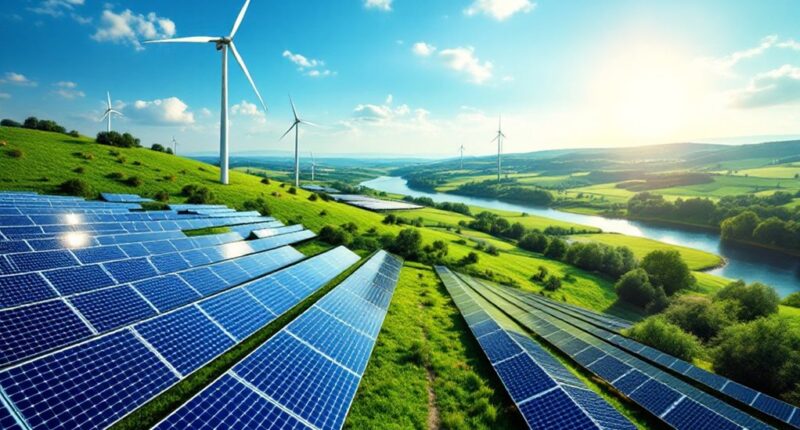Renewable energy growth is skyrocketing, with solar and wind dominating the scene. In 2024 alone, global renewable capacity jumped 585 gigawatts, largely fueled by China’s significant contributions. However, the geopolitical landscape reveals disparities, as G20 nations lead in capacity while emerging markets struggle. This situation presents both hurdles and chances for equitable investments in clean energy. The shift toward sustainability could reshape energy dynamics, and the possibilities are as exciting as they are crucial. Curious for more?

In the ever-evolving landscape of energy, it seems everyone is joining the green revolution—like an enthusiastic crowd at a concert, swaying to the same catchy tune. The global renewable energy capacity surged dramatically in 2024, adding a record 585 gigawatts, marking a 15.1% annual growth. This expansion, fueled primarily by solar and wind, accounted for over 90% of total power growth worldwide. With the total renewable capacity reaching an impressive 4,448 gigawatts, it’s clear that the green movement is gaining momentum.
The green revolution is gaining momentum, with renewable energy capacity soaring by a record 585 gigawatts in 2024.
Solar energy took center stage, with photovoltaic (PV) systems increasing by 451.9 gigawatts, bringing the total to 1,865 gigawatts. China, the rockstar of solar additions, contributed a whopping 278 gigawatts, while India followed with a commendable 24.5 gigawatts. Solar is set to meet about half of the anticipated global electricity demand growth in 2024-2025, proving that it’s not just a passing fad. If current trends continue, solar PV is poised to eclipse hydropower as the largest renewable source by 2029. Grid modernization is essential to support this rapid growth and ensure the resilience of the energy infrastructure. Furthermore, the significant rise in ethane production is indicative of the broader trend towards integrating renewable sources with traditional energy markets.
Wind power also enjoyed a growth spurt, reaching 1,133 gigawatts, though onshore additions in the U.S. faced some hiccups. However, offshore wind is experiencing a renaissance, with investments flowing in like an invigorating breeze. Meanwhile, battery storage capacity nearly doubled in 2024, showcasing a remarkable growth trend that reflects the increasing need for energy flexibility.
While the G20 countries dominated new capacity additions, regional disparities remain. China accounted for an astonishing 64% of global renewable growth, while emerging markets outside China struggled to keep pace. This unevenness highlights both challenges and opportunities within the geopolitical landscape of renewable energy. As countries navigate the path toward sustainability, the call for equitable energy investment and growth has never been more urgent.
The renewable revolution is not just a trend; it’s a pivotal shift that could reshape global energy dynamics, leaving an indelible mark on the future.
Frequently Asked Questions
What Are Some Lesser-Known Renewable Energy Sources Gaining Traction?
Emerging renewable energy sources are quietly making waves, like sand batteries that store energy as heat in silica, boasting less than 2% thermal loss—perfect for taming renewable energy’s fickle nature.
Then there are residential wind turbines, compact and urban-friendly, turning gusts into useful power. Also on the menu, renewable natural gas captures methane from cows, transforming it into energy—because why waste a good “moo”? These innovations could reshape energy landscapes, one clever idea at a time.
How Can Individuals Invest in Renewable Energy Projects?
Individuals can invest in renewable energy projects through several engaging methods.
They might consider crowdfunding platforms like Trine for solar initiatives or GoParity, where even a €5 investment can spark sustainability.
For the stock market enthusiasts, ETFs like iShares Global Clean Energy offer a basket of green companies.
Alternatively, installing rooftop solar panels or buying green energy certificates lets them be eco-friendly at home, all while making their wallets a little greener too
What Role Do Energy Storage Technologies Play in Renewable Energy?
Energy storage technologies are like the trusty sidekick of renewable energy systems. They smooth out the bumps of fluctuating production, ensuring a steady supply, even on cloudy days or still nights.
Think of batteries as energy’s personal assistants, storing excess power for those rainy spells. With various options like pumped hydro and thermal storage, they help keep the grid stable and make sure the lights stay on—no superhero cape required
How Can Renewable Energy Reduce Energy Poverty Globally?
Renewable energy has the potential to considerably reduce global energy poverty. By providing electricity to underserved areas, it can light up homes and schools like a surprise party.
It also helps improve health by cutting down harmful indoor air pollutants—think of it as swapping smoky kitchens for fresh air. Additionally, renewable jobs can spring up faster than weeds in a garden, offering communities new opportunities and a brighter future. Now that’s a win-win.
What Skills Are Needed for Careers in the Renewable Energy Sector?
In the renewable energy sector, a mix of technical and soft skills is essential. Engineers must master the intricacies of solar panels and wind turbines, while data analysts decode energy trends like detectives on a case.
Communication is key, turning complex jargon into digestible bites for everyone. Collaboration across cultures? Absolutely It’s like a global potluck, where every idea adds flavor.
With adaptability and critical thinking, professionals are ready to tackle the energy challenges of tomorrow.









